Temperance Hotels
Temperance Hotels
Perry's Hotel, Albany Hotel & London / Fernleigh Hotel
The temperance movement in the United Kingdom originated as a mass movement in the 19th century against drunkenness and excess, albeit concentrating their efforts on spirits rather than wine and beer. Early on various non-conformist groups, notably the Methodists, Quakers and the Salvation Army (founded in 1864), lobbied parliament to restrict alcohol sales. The Church of England Temperance Society was founded in 1862.
As well as the three temperance hotels described here, Yeovil also had several temperance societies as well as other temperance establishments such as the Rising Star (also known as the British Workman's Public House) and, between 1894 and 1919, the 'Come and Welcome Coffee Tavern' at 5 Wine Street.
Perry's Family & Commercial Temperance Hotel
Although the first temperance hotel in the country opened in Preston, Lancashire, in 1833 it was not until the 1850s that Yeovil was provided with such an establishment - Perry's Family & Commercial Temperance Hotel in South Street run by technical blacksmith John Perry, who was certainly running his hotel by 1856. A strong believer in the temperance movement, Perry had even named one of his daughters Temperance.
Perry's Family & Commercial Temperance Hotel was listed in the Post Office Directories of 1866 and 1875 and It appears that while John concentrated his time in the smithy, his wife Jemima had actually run the hotel. In the winter of 1869 Jemima died, aged 64, and in the autumn of the following year John married Martha Mooney in Yeovil. However it appears that the hotel was bought by William Waygood, certainly by early 1870, although he kept the name Perry's and it is likely that the hotel was being managed by John Perry's son, John Jnr. who was in residence in 1871.
William Waygood left Yeovil shortly after this and the hotel continued to be run by John Perry Jnr. The Post Office Directory of 1875 listed John Perry of the Temperance Hotel in South Street and in 1882 Whitby's Yeovil Almanack Advertiser listed John at the Family & Commercial Temperance Hotel. There are, however, no further trade directory listings after this date and it is likely that the building was demolished during the 1880s.
The Albany Temperance Hotel
In the 1871 census 17 Middle Street was listed as a Temperance Hotel run by 31-year old William Waygood who lived above the premises with his wife Jane, their two children and two servants. The Waygoods had only recently moved to Yeovil from Semley, Wiltshire, where their daughter had been born in 1869. In 1870 William had bought Perry's Family & Commercial Temperance Hotel (see above). The Waygoods, however, soon left Yeovil and moved to Bristol, then London. The hotel was bought by William Gould, a shoemaker and also a Queensland Emigration Agent..
This probably coincided with the rebuilding of the hotel in 1872-3. During September 1872 a new water main was laid down Middle Street but a couple of weeks later there was a massive subsidence in the road one evening leaving a hole some thirty feet long, five feet wide and three feet deep immediately in front of the hotel causing the foundations to subside and the walls to crack apart necessitating the demolition and rebuilding of much of the building. The news item from the Taunton Courier of 9 October 1872 (shown below) relates that an accident occurred as the hotel was being pulled down. The name 'Albany' seems to have been applied after the rebuild at which time (certainly in 1873) it was managed for a brief time by William Phillips who won a court case concerning debt of a lodger.
In the Post Office Directory of 1875 it was listed as the Temperance Hotel of William Gould & Son but seems to have been managed by Edwin Arthur Raffill - certainly in 1878 when he was fined for 'allowing a dog to be at large' (see below).
|
In the 1891 edition of 'Where to Buy' the Albany Temperance Hotel was given the following description -
The
Albany
Temperance
Hotel,
We
have had
a stone,
an iron
and a
golden
age, and
the
present
might
not
inappropriately
be
termed a
coffee
tavern
age, so
great
has been
the
development
of these
desirable
houses
of
entertainment.
In
former
times
coffee
houses
were
regarded
with a
certain
amount
of
disfavour,
as not
being
desirable
places
of
abode;
but of
late
years
all this
has
changed,
and now
some of
the most
palatial
buildings,
with
well-furnished
and
ventilated
rooms,
most
perfect
sanitary
arrangements
and best
cuisine
are
associated,
along
with
perfect
cleanliness
and good
order,
with the
temperance
hotel.
|
In the 1891 census, the building was listed as a Coffee Tavern, managed by 44-year old Tom Dumbleton who also lived above the premises with his wife Maria, their four children and two servants; a barmaid and a domestic servant. The publication 'Where to Buy' of 1895 listed the building as the Albany Temperance Hotel with T Dumbleton as manager.
In March 1887 William Mitchelmore had opened the Abbey Hotel & Coffee Tavern, a temperance establishment in Glastonbury and the 1891 census listed him as a temperance hotel proprietor at 3-5 Benedict Street, Glastonbury. In 1895 he moved to Yeovil, purchasing the Albany Temperance Hotel. The Western Gazette Almanac of 1896 noted that William was the proprietor of the Albany Temperance Hotel & Restaurant, a listing repeated in Whitby's Yeovil Almanack Advertiser of 1898. In the 1901 census he was listed as a Hotel Proprietor (Temperance) at the Albany Temperance Hotel together with wife Ellen and son Howard, a domestic servant, a waitress and a boots, together with two hotel guests. He was further listed in Collins' Yeovil Directory of 1907 and in Kelly's Directory of 1919.
In the spring of 1920 William Mitchelmore quit business at the Albany Hotel, letting the premises and selling off the hotel's furniture and equipment. He presumably still owned the property and also owned and ran the Fernleigh Temperance Hotel (see below). Since this time, it is believed that the property has been a succession of shops.
The London / Fernleigh Commercial Temperance Hotel
The London Commercial Temperance Hotel was built on the corner of Middle Street and Station Road, most likely in the mid-1860s (certainly the block of buildings in identical architectural style on the other side of Middle Street had been built in 1863 - there's a datestone at high level at the rear of Ward & Sibley's shop).
Mercy Wreyford was born in Teignmouth, Devon, in 1814. In 1837 at the Independent Chapel at Newton Abbot, Devon, she married Benjamin Hebditch (1813-1867). Benjamin and Mercy, who never had children, initially set up home in Haselbury Plucknett but had moved to Crewkerne by 1851 where they lived in the Market Hall and Benjamin worked as a Grocer and Tea Dealer. They were still there in the 1861 census but Benjamin died in the spring of 1867. After his death Mercy moved to Yeovil and in 1868 she was referred to in a court case as "Mrs Mercy Hebditch of the London Temperance Hotel, Townsend" - the first mention of a hotel at this location. In the 1871 census she was listed at 17 South Western Terrace as a Hotel Keeper in an un-named hotel. Living with her was a cook, a general servant and four boarders. Mercy was listed in the Post Office Directory of 1875 as running a 'Temperance Hotel in Middle Street'. Mercy left the hotel in 1876 (she died in Yeovil on 9 February 1899 aged 84) and the hotel was taken on by none other than Edwin Raffill (he from the Albany Hotel with a biting dog) who ran the hotel for three years. Raffill left in March 1879.
The hotel was acquired by Miss AJ Phelps but she left In May 1882 the hotel was re-let and the notice of intended letting is interesting since it describes the hotel's accommodation as "contains coffee, commercial and private sitting rooms, with 11 bed-rooms" (see below). During June 1882 the whole of the hotel's contents and furniture were sold off by auction. In 1882 Whitby's Yeovil Almanack Advertiser listed the hotel as the London Temperance Hotel and several newspaper small ads were placed seeking staff during this year.
By 1898 it had been renamed the Fernleigh Hotel and was listed in Whitby's edition of that year as a Temperance Hotel owned by WH & E Whitlock. It would appear that the hotel was sold in July 1909 and between 1914 and 1919 William Mitchelmore was listed as the hotel keeper of not only the Albany Temperance Hotel, above, but also the Fernleigh Commercial Temperance Hotel.
By the mid-1930s William Mitchelmore's son Howard was running the Fernleigh. He was listed in Kelly's Directory of 1935 as the proprietor of the Fernleigh Commercial Hotel which, it was noted, was still a temperance establishment. The Fernleigh Hotel was certainly still open in 1936 as evidenced by several newspaper small-ads seeking staff although at this time the word 'unlicensed' was preferred to 'temperance'.
In the summer of 1937 the hotel was sold (see below) and in August 1938 the Western Gazette was running notices that the Fernleigh Hotel was to be let, the notices stating that "This prominent building lends itself to many practical uses".
For many years after the Second World War the old Fernleigh Temperance Hotel was the offices of the Southern National bus company. Its most recent use was as an Indian restaurant but at the present time (August 2015) has been empty for about a year.
gallery
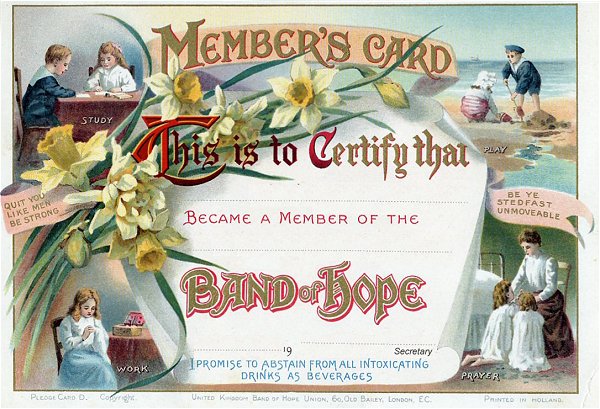
A 'Band of Hope' membership card from around the time of the First World War.
![]()
Perry's Family & Commercial Temperance Hotel
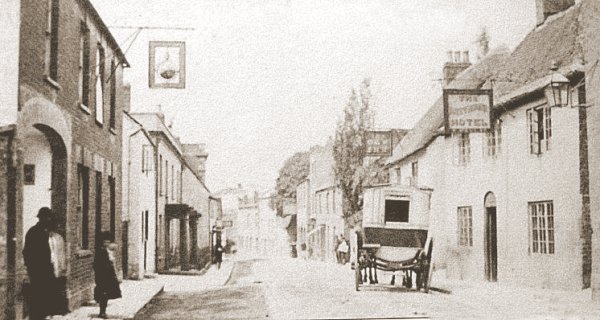
This photograph of South Street was taken around the 1890's and shows the Globe and Crown at left, opposite is the Greyhound Hotel and next door to that was the Cow Inn. Just visible at the end of the street is the Three Choughs Hotel and the King's Arms. Between the Choughs and the Cow was also the Market House Inn and three un-named beerhouses. Despite the huge number of pubs in this short run of South Street, the white building with the black porch left of centre was John Perry's Temperance Hotel.

An advertisement placed in the 27 May 1870 edition of the Western Gazette announcing that William Waygood's market day dinners at the hotel. By the following year Waygood was also running the Albany Temperance Hotel in Middle Street.
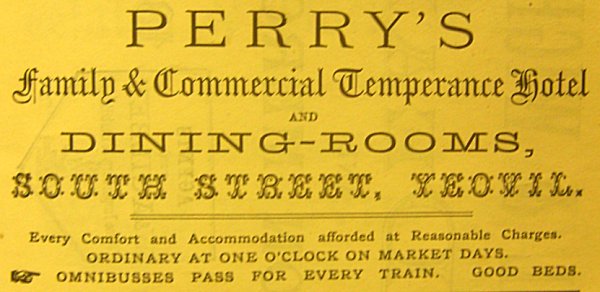
An advertisement in Whitby's Yeovil Almanack Advertiser of 1882. The name Perry's was retained even though it was now owned by William Waygood.
![]()
The Albany Temperance Hotel
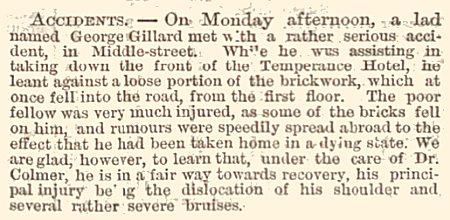
This report from the 4 October 1872 edition of the Western Gazette confirms that the old temperance hotel was demolished and the new hotel, shown in the photographs below, therefore dates from 1873. The name 'Albany' seems to have been applied after the rebuild.
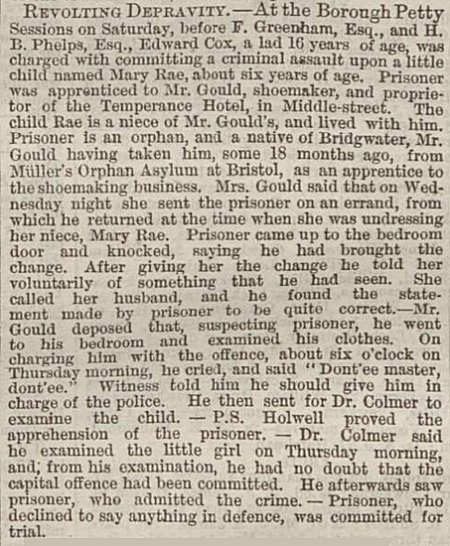
You'll never look at the building in the same way after reading this gruesome account as reported in the Western Gazette's edition of 29 August 1873.

A report from the 6 July 1878 edition of the Somerset County Gazette concerning Edwin Raffill's court case. He ran the hotel for three years after Mercy Hebditch's departure. He left the hotel the following year.
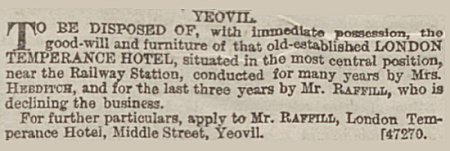
Edwin Raffill decided to leave - this notice is from the 21 March 1879 edition of the Western Gazette.

Small ad which ran daily for a week during August 1887 in the Western Daily Press. Applying by letter with a photo? - you wouldn't get away with that these days.
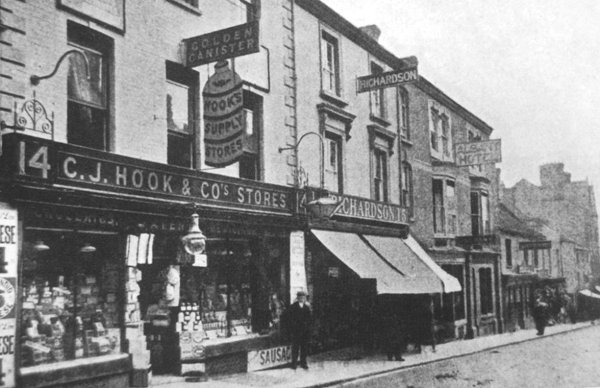
This photograph
features in my
book 'Yeovil From Old Photographs'.
The Albany Hotel at right in this photograph of 1897 by Jarratt Beckett - it had been rebuilt in 1873. To give an idea of where this is, the entrance to Frederick Place (the archway is an integral part of the rebuilt hotel building and therefore also dating to 1873) is beneath the two single windows at the left end of the Albany Hotel and obscured by the awnings.
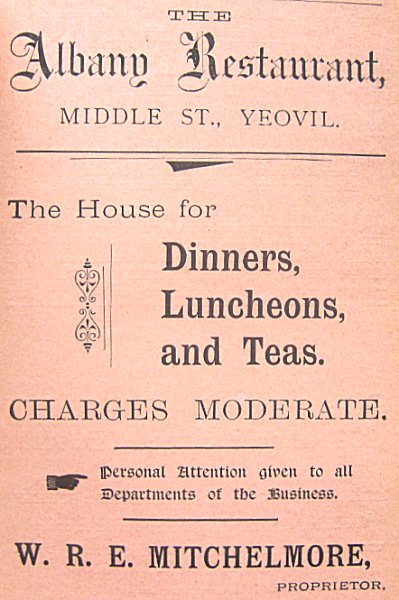
An advertisement for the Albany Hotel from Whitby's Yeovil Almanack Advertiser of 1900.
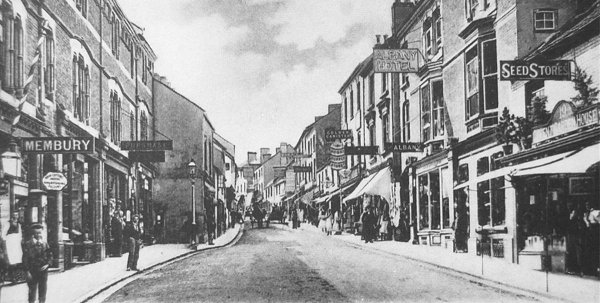
Taken about 1900, this photograph looks west along Middle Street towards the Borough. The Albany Hotel and Restaurant is at right.
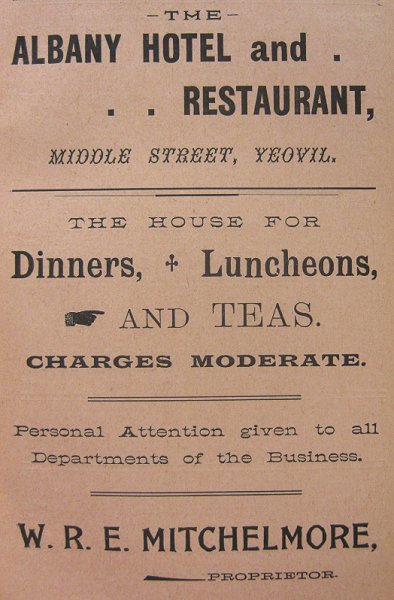
An advertisement for the Albany Hotel from Whitby's Yeovil Almanack Advertiser of 1910.
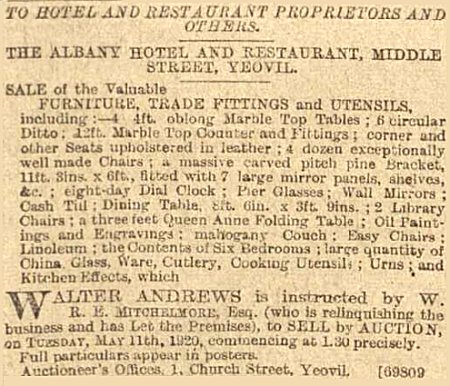
The Albany Hotel finally closed in 1920 when William Mitchelmore sold the business. This notice of the sale of the hotel's fittings and equipment was placed in the 30 April 1920 edition of the Western Gazette.
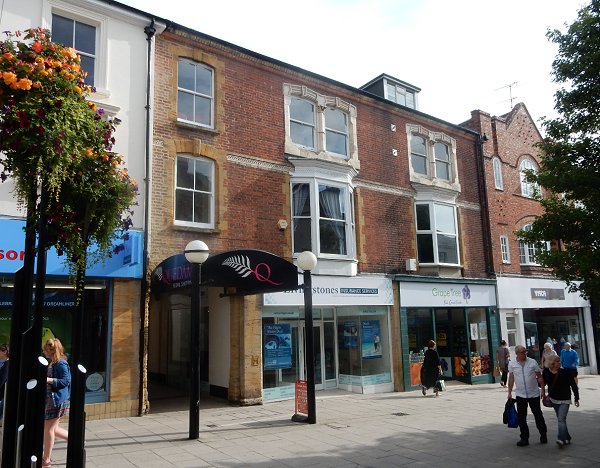
Photographed in 2015, it's nice to see that the Albany Hotel building survives.
![]()
The Fernleigh Temperance Hotel

A notice placed in the 19 May 1882 edition of the Western Gazette announcing the intended letting of the hotel.
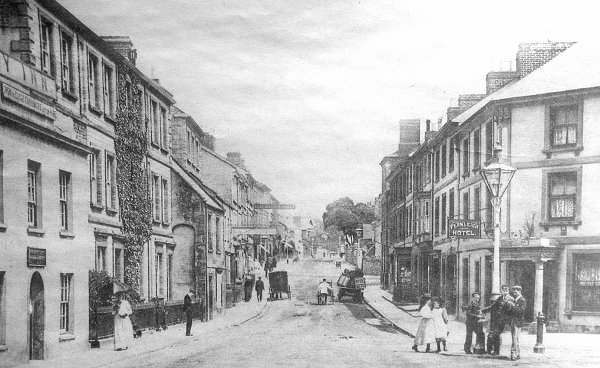
Courtesy of the
Western Gazette
Lower Middle Street, photographed around 1895. The Railway Inn at left and the Fernleigh Temperance Hotel at right.
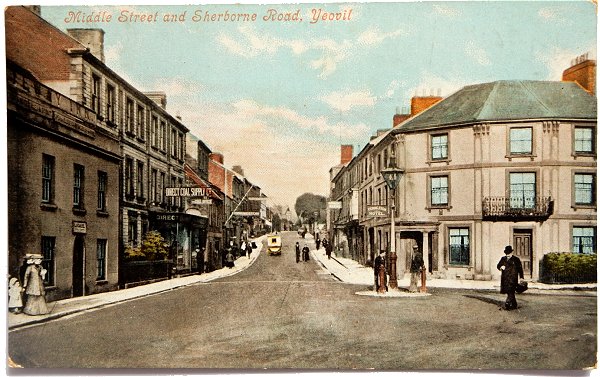
From my
collection
-
This photograph
features in my
book 'Yeovil From Old Photographs'.
An all but identical view to the previous photograph, this postcard appeared in several forms - monochrome and at least three different hand-coloured versions. This one was used in 1907.
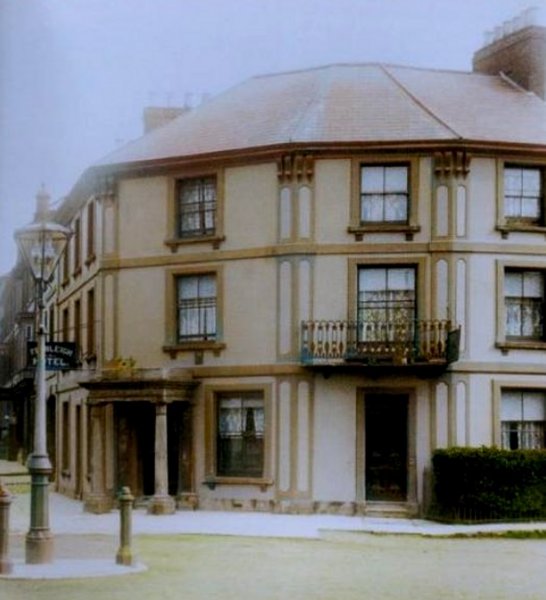
The Fernleigh Hotel in a colourised photograph of 1903.
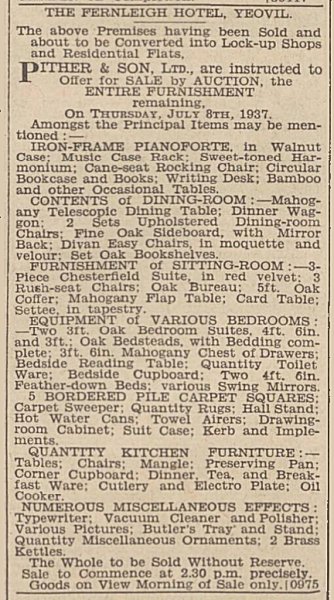
Notice of the sale of all the furnishings of the hotel in the 25 June 1937 edition of the Western Gazette. By this time the hotel itself had been sold and was to be converted into shops and flats.
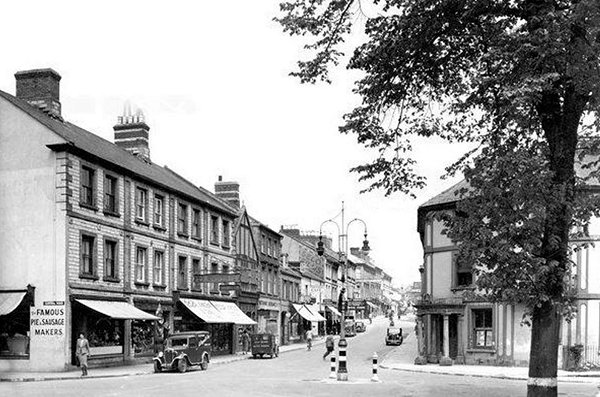
.... and pretty much the same view in the 1940s when the building retained its lovely porch
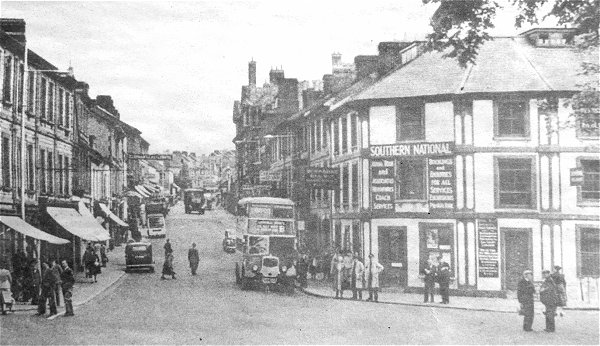
Courtesy of the
Western Gazette
Lower Middle Street, photographed around 1955. By this time the Fernleigh Temperance Hotel at right had become the offices of the Southern National bus company. Is it me, or does that bus look particularly tiny?
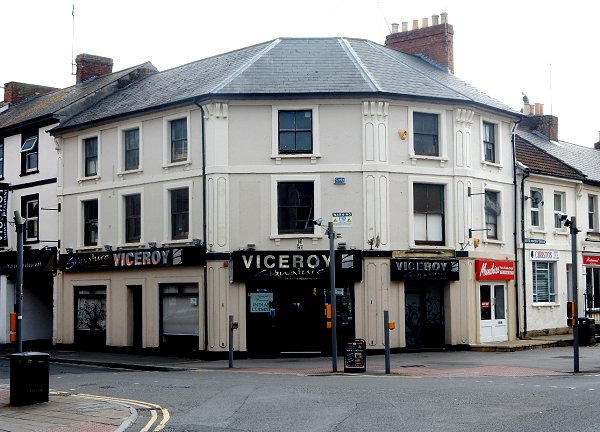
The Fernleigh Temperance Hotel building, photographed in 2015. The restaurant has now been closed for a year.